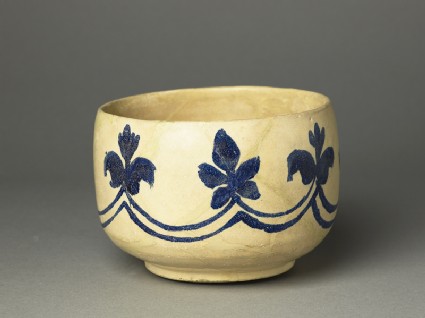Search Results: objects
Show search help- Reference URL
Actions
Mortar-shaped bowl with vegetal decoration
-
Details
- Associated place
- Date
-
9th century AD (AD 801 - 900)
Abbasid Period (AD 750 - 1258)
- Material and technique
- earthenware, with an opaque white glaze, and painting in blue
- Dimensions
-
9.5 cm (height)
13 cm (diameter)
at foot 8.4 cm (diameter)
- Material index
- Technique index
- Object type index
- No. of items
- 1
- Credit line
- Gift of Gerald Reitlinger, 1978.
- Accession no.
- EA1978.2137
-
Further reading
Allan, James W., Islamic Ceramics, Ashmolean-Christie's Handbooks (Oxford: Ashmolean Museum, 1991), no. 1 on p.6, illus. p. 7
London: Hayward Gallery, 8 April-4 July 1976, The Arts of Islam, Dalu Jones and George Michell, eds (London: Arts Council of Great Britian, 1976), no. 253 on p. 214
Oxford: Ashmolean Museum, 24 May 2006-23 December 2008, Treasures: Antiquities, Eastern Art, Coins, and Casts: Exhibition Guide, Rune Frederiksen, ed. (Oxford: Ashmolean Museum, 2006), no. 204 on p. 73, illus. p. 73
Tamari, Vera, ‘Abbasid Blue-on-white Ware’, James Allan, ed., Islamic Art in the Ashmolean Museum, Part Two, Oxford Studies in Islamic Art, 10 (Oxford: Oxford University Press, 1995), x.2, p. 121, illus. p. 118 fig. 2
Paris: Institut du Monde Arabe, 27 November 2012-28 April 2013, Les mille et une nuits, Elodie Bouffar and Anne-Alexandra Joyard, eds (Paris: Institut du Monde Arabe, 2012), cat. p. 378, illus. p. 61
Glossary (2)
earthenware, glaze
-
earthenware
Ceramic material made of clay which is fired to a temperature of c.1000-1200⁰c. The resulting ceramic is non-vitreous and varies in colour from dark red to yellow.
-
glaze
Vitreous coating applied to the surface of a ceramic to make it impermeable or for decorative effect.
Location
Objects are sometimes moved to a different location. Our object location data is usually updated on a monthly basis. Contact the Jameel Study Centre if you are planning to visit the museum to see a particular object on display, or would like to arrange an appointment to see an object in our reserve collections.
Publications online
-

Islamic Ceramics
The import of Chinese white wares and the high-fired porcelains into Iraq in the ninth century led the local Arab potters to experiment in reproducing the whiteness of the Chinese originals in their own low-fired pottery. The Iraqi pottery body fired to a yellowish bluff colour, and one of the ways the potters developed to make this look white was to cover it with a tin-glaze - a glaze which is made white and opaque by the addition of tin-oxide. This tin-oxide also reflected the eastern trade links of early Islamic Iraq, for, with no tin mines in the Islamic Near East, the metals had to be imported by sea from southern Burma and Malaysia. Occasionally the Iraqi potters were content to leave their products completely plain, like the Chinese originals, but more often they preferred to decorate them, using the white as a ground for the blue (cobalt) and green (copper) designs.
These two bowls [EA1978.2137 & EA1978.2141] illustrate four decorative themes typical of early Islamic pottery. The first, which appears on both pieces, is the palmette, traditionally a five-petalled blossom, from which the later ‘arabesque’ derived (see no. 9 [EA1956.130]). The second is geometry, the central part of the design of the lower bowl being made up of a square within a diamond. The third is stylisation: in the second bowl the highly stylised palmette is about as far from its natural parent as it could be, illustrating a taste common in the Islamic painting tradition as well as in ceramics. Fourthly, the second bowl is decorated with green splashes, a taste common in less expensive pottery objects in areas stretching from Egypt to Iran during early Islamic times (see no. 5 [EA1978.1759]).
Collection trails
Galleries
© 2013 University of Oxford - Ashmolean Museum












